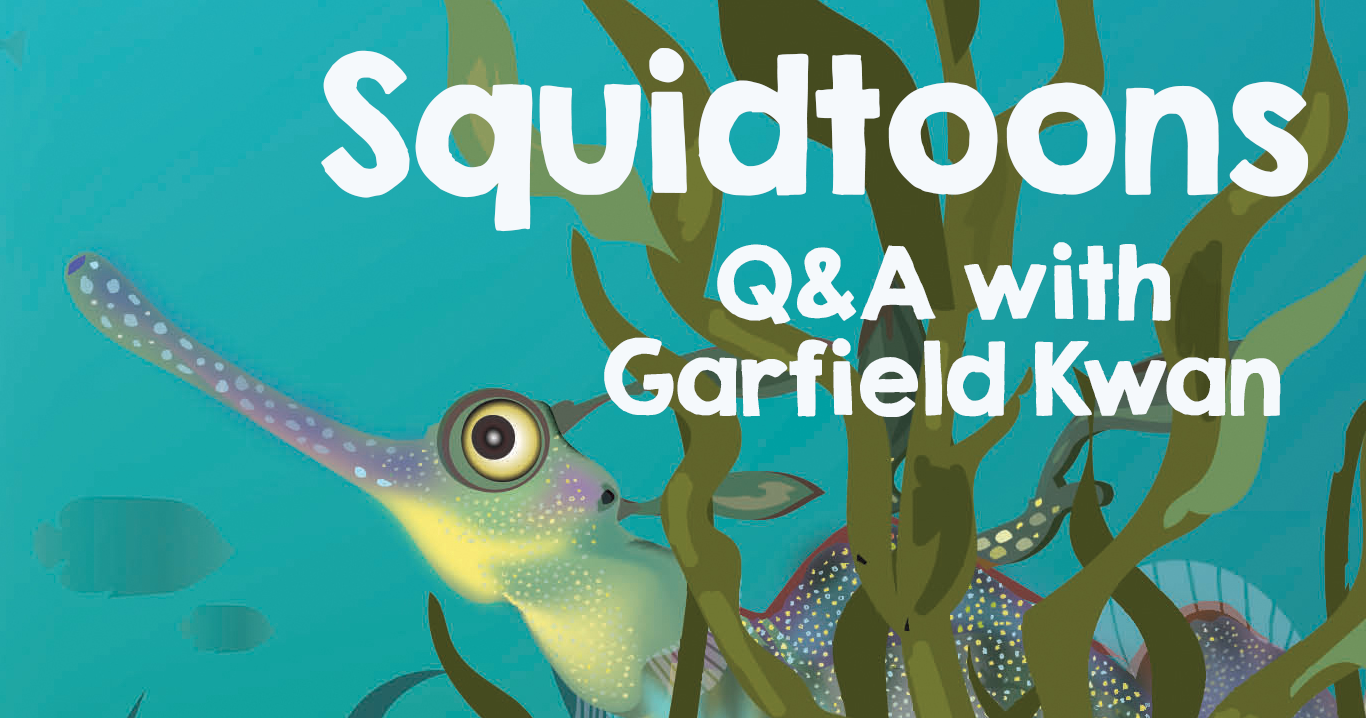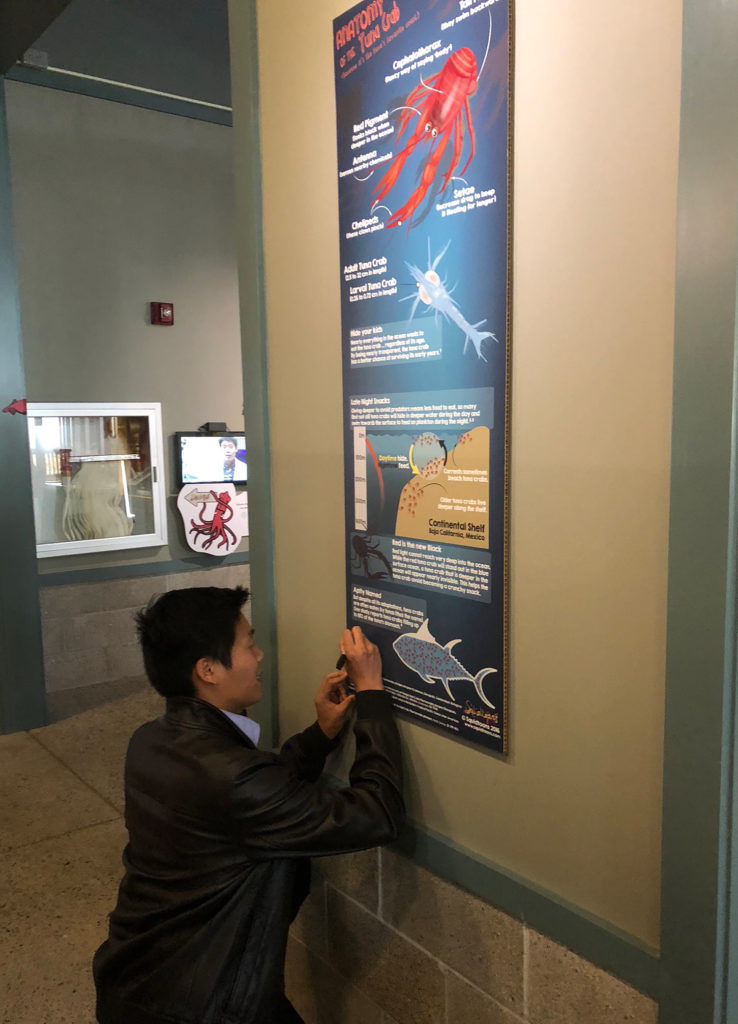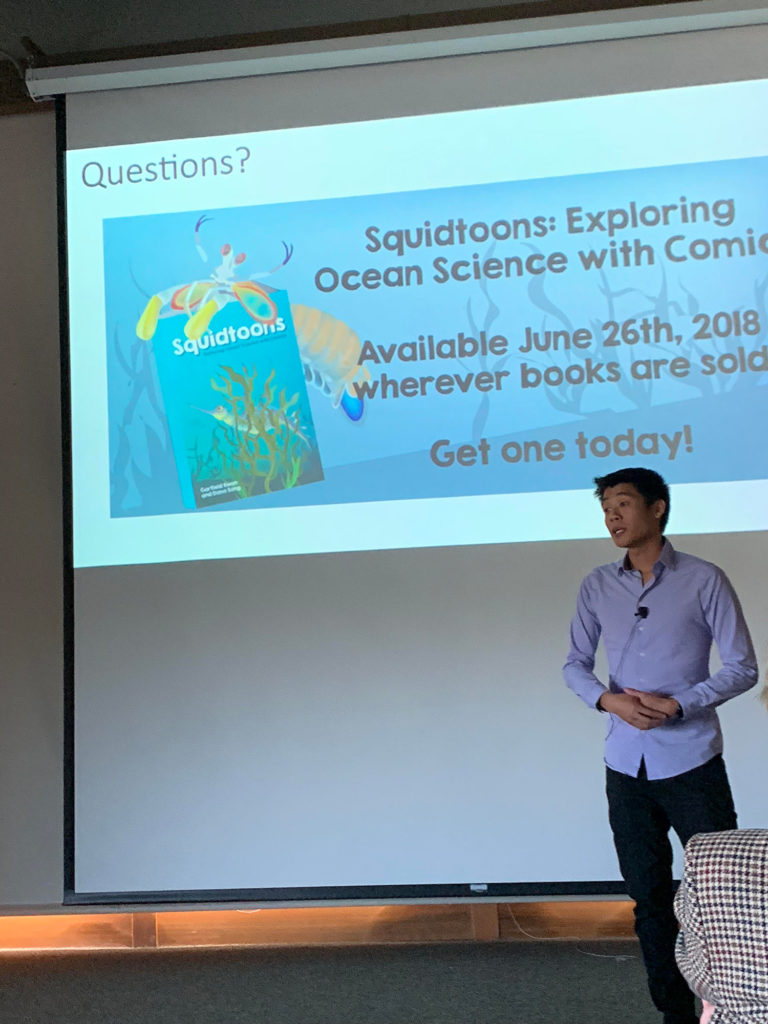
Some of our favorite comics bring magic to life on the page, but fifth-year Ph.D. student and author Garfield Kwan finds the fantastic here in the real world. His book Squidtoons: Exploring Ocean Science with Comics is a deep dive into some of the world’s weirdest sea critters, with beautifully drawn comics that are entertaining, educational and full of surprises. Just ask Kids’ BookBuzz reviewer Nishaant, age 10, who said, “I never knew whale vomit was so valuable.”
Squidtoons, which first made a splash online in 2013, came to Andrews McMeel Publishing last summer at the recommendation of another aquatic artist: Sherman’s Lagoon creator Jim Toomey. With its unique way of adapting STEM concepts into hilarious comics, it was a natural addition to our middle-grade line. Since being published in June 2018, the book has made waves throughout the children’s book market. Recently, Red Tricycle named it as one of the best new kids’ books of 2018.
With so much ocean to explore, Kwan’s research at Scripps Institution of Oceanography keeps him busy, but he took a quick study break to spill some insights on his work.
AMP: So, marine biology and comics. It’s not a combo that immediately comes to mind, but Squidtoons makes the pairing feel as natural as peanut butter and jelly. Where’d this idea come from? Why comics?
Garfield Kwan: The idea came from my personal struggle in learning English when I first immigrated from Hong Kong at the age of 8. Learning English was difficult, but the accompanying visuals within comics and picture books made it easier to understand the text, and ultimately the message. (Fun fact: This is also how I chose “Garfield” as my name after reading many of Jim Davis’ Garfield comics.) Today, I now apply the same principle in Squidtoons, but instead of English, it’s scientific research (which at times can seem like a different language).
 AMP: A lot of the charm of Squidtoons comics comes from their fun and accessibility. Why do you think it’s important that anyone—even those of us who haven’t taken a biology class since high school—can read them and learn about ocean life?
AMP: A lot of the charm of Squidtoons comics comes from their fun and accessibility. Why do you think it’s important that anyone—even those of us who haven’t taken a biology class since high school—can read them and learn about ocean life?
GK: Good question. The short answer is because 1) the ocean affects everyone and 2) ocean research costs money.
The ocean produces roughly half of the Earth’s oxygen, provides a source of protein to one in seven people (that’s a bit over a billion) and houses a suite of organisms that contain anti-cancer and antibiotic chemicals. That’s just three of many good reasons to continue studying these underwater critters.
Also, ocean research isn’t free. It’s funded by tax dollars and generous donations. So, if you care about the above reasons (air, food, medicine) or simply like the cute sea otters or the awesome thresher shark, then keep supporting science with your interest, your vote and/or your wallet.
AMP: A few Squidtoons comics tackle misconceptions about sharks and their bad rap in Hollywood. What do you hope to convey to readers who might be afraid of the oceans’ toothier inhabitants?
GK: The problem with Hollywood scary-shark-attack movies is that the resulting stigma influences ocean policies. Sharks are just like other wild predators and are a vital part of the ecosystem. We can and need to coexist together to maintain a healthy ocean. You should treat sharks the same way you would treat lions, tigers and bears (oh my!) After all, they are apex predators and we are in their natural territory. Treat jumping into the ocean the same way as wading into the jungle, and realize there are risks to every situation
AMP: Of course, there are two other important members of the Squidtoons team: chief scientific illustrator Dana Song and editor Kaitlyn Lowder. How does each member contribute to making Squidtoons comics both fun and accurate?
GK: It takes a whole lot of work to translate complex research into simple yet accurate comics! My work involves selecting and researching the topic, drafting and storyboarding the comic, communicating with the reviewers, editing text and visuals, maintaining the website and directing the workflow.
Dana Song is a fantastic artist who transforms the research topics I’ve selected into appealing artwork. Her lack of a marine biology background actually benefits Squidtoons as it provides an outside perspective to balance out my scientific views.
Kaitlyn Lowder is also currently a marine biology graduate student with an expertise in crustaceans (e.g., lobsters, crabs), and her editing keeps Squidtoons honest. Her work plays a key role in keeping our errors to a minimum prior to online publication.
All together, our roles keep Squidtoons a visually appealing yet scientifically accurate resource for the public to enjoy.
 AMP: Talk to us about what a day of marine biology research looks like for you. How often do you have to scuba-gear up and take your study out to sea?
AMP: Talk to us about what a day of marine biology research looks like for you. How often do you have to scuba-gear up and take your study out to sea?
GK: While some marine biologists regularly SCUBA dive for their work, I do not need to dive in the ocean for my research. Marine biologists ask many different questions, and there are unique techniques to find each answer. These techniques range from deploying instruments in remote parts of the world while on months-long cruises, to maintaining aquariums on land for studying the physiology of marine animals. I fall in the latter category—maintaining aquariums and studying marine fish physiology.
Though our techniques may be different, it may surprise you that reading and writing take up much of a marine biologist’s time. We have to read other scientists’ reports to think of new experiments, then we have to write to request funds for experiments AND to report our findings to other scientists. If you want to be a marine biologist, be sure to keep those things in mind!
My typical day may include any combination of the following: feeding animals, maintaining aquariums, running experiments, teaching others to run experiments, reading about previous work, writing about my current work, and writing to request funding for future work. On a side note, reading previous research articles is how many of the Squidtoons pieces came to be!
AMP: You’ve made quite a few public appearances since Squidtoons was published this past summer. What’s your favorite part of these events?
GK: My favorite parts are the interactions with readers and fans. The [San Diego Festival of Books] exposed me to readers from all backgrounds, whereas the Sharktoberfest event in San Francisco attracted ocean lovers. Both events were wonderful, and the readers’ genuine appreciation of my work makes this extraordinary effort worth it.
AMP: Finally (and most importantly), what’s your favorite sea creature and why?
GK: I’ve been asked (and tried answering) this many times before, but I really can’t decide on a favorite sea creature. There are simply too many animals with wicked cool adaptations. This is probably a good problem to have because I won’t ever run out of things to research or draw comics about!
Squidtoons: Exploring Ocean Science with Comics is available now! You can also follow Garfield and team’s work on Facebook and Squidtoons.com.
